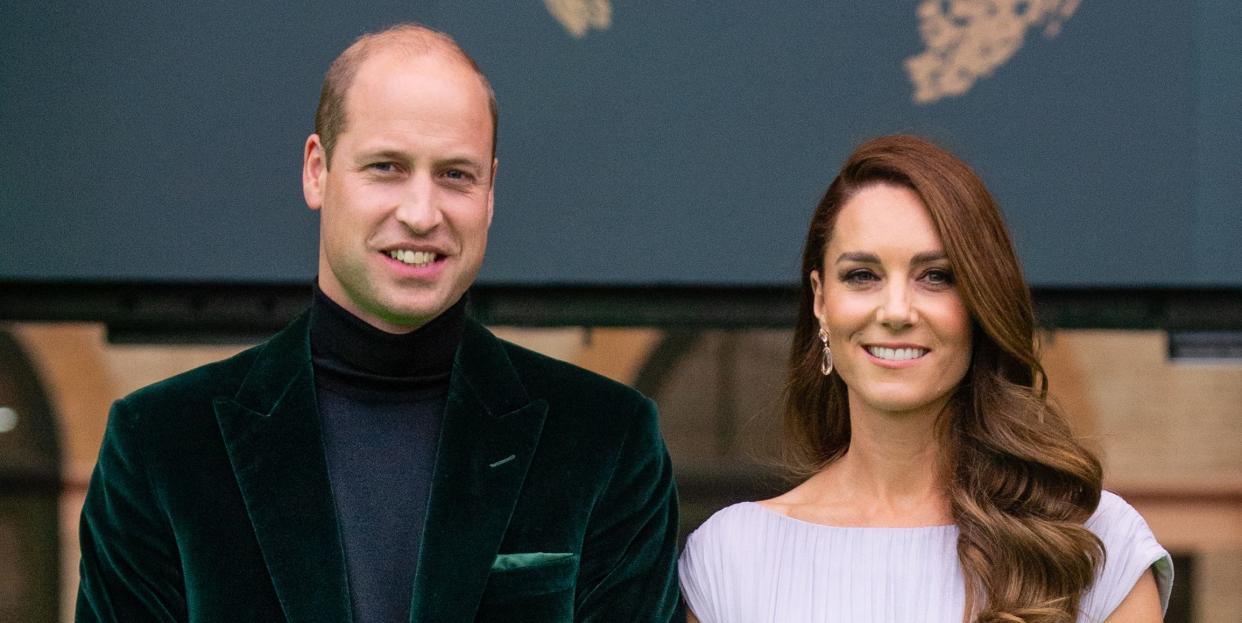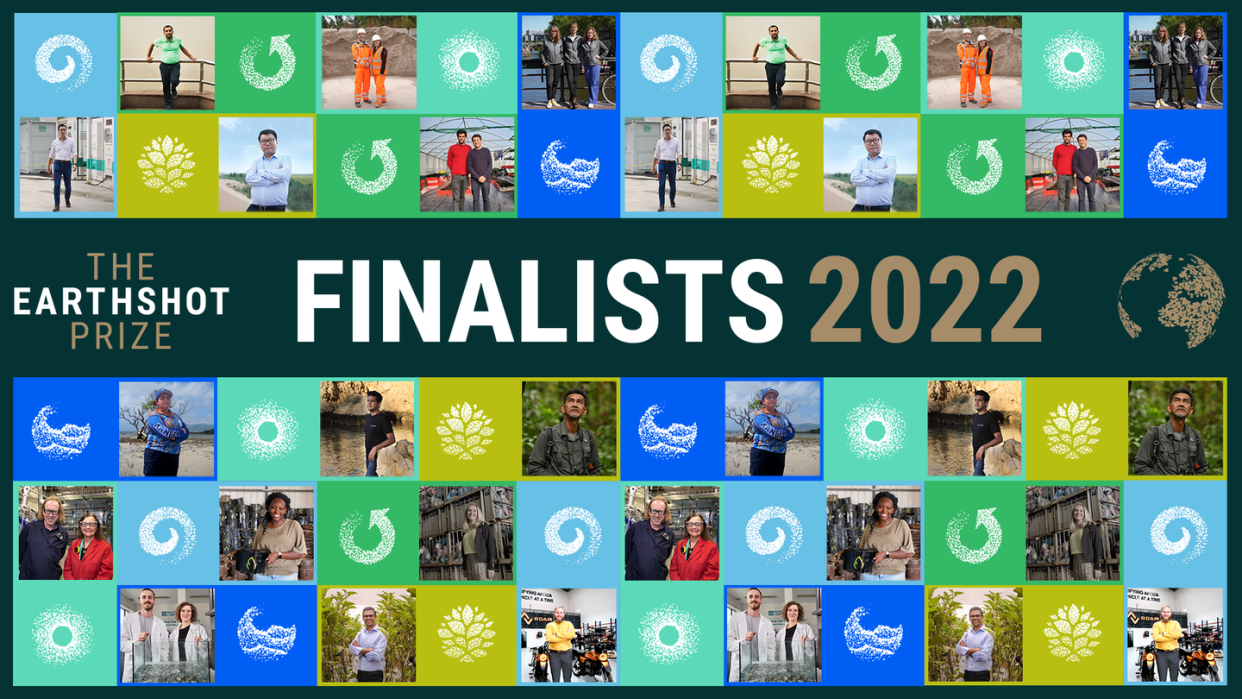Prince William's Earthshot Prize Is Here

Prince William and Kate Middleton will soon travel to the U.S. for the first time in eight years to host his Earthshot Prize in Boston. And today, the 15 finalists for the prestigious environmental prize can be revealed, including a sustainable leather alternative and an organization which makes packaging from seaweed.
There are three finalists in each of the five award categories, and at the event on December 2 in Boston’s JFK Presidential Library and Museum one winner from each category will be announced. Chosen by an Earthshot Prize Council which includes Prince William, Queen Rania of Jordan, Sir David Attenborough, and Shakira, the five winners will each receive £1 million to develop and expand their environmental solution.
“The innovators, leaders, and visionaries that make up our 2022 Earthshot Finalists prove there are many reasons to be optimistic about the future of our planet," Prince William said in a statement today. “I am so excited to celebrate these fifteen Finalists and see the five Winners of The Earthshot Prize announced in Boston—the hometown of President John F. Kennedy, who shared The Earthshot Prize’s belief that seemingly impossible goals are within reach if we only harness the limitless power of innovation, human ingenuity, and urgent optimism.”
William and Kate will be joined by climate experts and activists, government leaders, business executives, celebrities, and influencers from around the world at the sustainably produced ceremony in Boston. This is the second Earthshot Prize following the inaugural event in London last year, and the Prize will be held every year for a decade with the aim of championing 50 innovative solutions to the climate crisis.

The 2022 finalists are:
PROTECT AND RESTORE NATURE
1. Desert Agricultural Transformation
China
Professor Yi Zhijian and his team have developed a technique to turn barren desert into lush and farmable land by applying a water-based paste mixed with sand to desert to give it the same properties as soil to grow crops. “Our solution transforms dry plains into productive pastures. We think we have found a solution to rising food insecurity, and we are proud of this recognition from The Earthshot Prize,” says Professor Yi.
2. Kheyti Greenhouse in a Box
India
Indian startup Kheyti, produces a Greenhouse-in-a-Box, which is designed for small-hold farmers and the crops they grow, offering shelter from the elements and pests. Ninety percent cheaper than a standard greenhouse, they can double farmers’ incomes. “Our Greenhouse-in-a-Box is empowering farmers in India today. The steps we have already taken at Kheyti are now building to change farmers’ lives at scale,” says Kheyti’s Kaushik Kappagantulu.
3. Hutan
Malaysia
Hutan has been working to develop solutions for a more harmonious coexistence between wildlife and people for the past 25 years. Their findings allow them to create strategic wildlife corridors and to reforest degraded areas with native trees, ensuring safe passage, food and shelter to orangutans and other species. "Through our research and conservation programmes in Sabah, Malaysian Borneo, we forge strong partnerships and develop innovative solutions for a more harmonious coexistence between wildlife and people,” says Isabelle Lackman of Hutan.
CLEAN OUR AIR
MukuruClean Stoves
Kenya
Charlot Magayi founded Mukuru Clean Stoves after growing up in Mukuru, one of Nairobi’s largest slums where she once sold charcoal for fuel. Rather than burning solid fuels, her stoves use processed biomass made from charcoal, wood and sugarcane which creates 90 percent less pollution than an open fire and 70 percent less than a traditional cookstove. “Mukuru Clean Stoves began as a solution to a problem that I had felt personally in my own life. Today, we have an opportunity to transform the lives of millions, with cheaper, safer and more sustainable cookstoves and fuels,” says Charlot.
2. The Ampd Entertainer
Hong Kong
Hong Kong entrepreneur Brandon Ng and his team at Ampd Energy have developed the Enertainer, an all-electric battery energy storage system designed to power construction sites without the need for direct use of fossil fuels. The system can power any type of electrical equipment — cranes, hoists, welders, barbenders and more — with its lithium-ion batteries, which are similar to those used in electric cars. “Construction is responsible for 11 percent of the world’s energy-related CO2 emissions, in part because of its reliance on burning fossil-fuels, which emits CO2, nitrogen oxides, particulate matter and other harmful fumes. The Enertainer eliminates the need for direct use of fossil fuels on construction sites,” says Brandon Ng.
3. Roam
Kenya
Roam, which began as a research project at a Swedish university, brings affordable, electric motorcycles and buses to Kenya. The company plans to produce 150,000 motorcycles and 800 buses per year by 2026 to make electric transport accessible to a broader market. “We want to help the environment, and drivers’ pockets,” says Filip Lovstrom.
REVIVE OUR OCEANS
1. SeaForester
Portugal
Pål Bakken and the SeaForester team are helping to restore seaweed to the ocean, which helps to capture carbon and restore ecosystems. They have created “green gravel” which is seaweed spores seeded onto small stones and scattered into the ocean to latch on to the reef so seaweed grows. “Our solution aims to restore what has been destroyed. Reforesting our seas will help reverse ocean acidification, build up fish stocks and curtail climate change,” says Pål Bakken.
2. The Great Bubble Barrier
Netherlands
The Great Bubble Barrier is designed to intercept plastic waste before it reaches the sea by creating a curtain of bubbles on rivers which directs plastic into a waste collection system. It has been proven to capture around 86 percent of plastic waste and there are plans to implement it in polluted rivers across the world. “Rivers are the highway to our oceans, transporting pollution all the way there. The Great Bubble Barrier stops plastic from reaching the sea by intercepting it from inland waterways,” says one of the creators Francis Zoet.
3. Indigenous Women of the Great Barrier Reef
Australia
The Queensland Indigenous Women Rangers Network is building the next generation of women rangers to help protect the Great Barrier Reef. The program has trained over 60 women, encouraging new conservation approaches by sharing knowledge, telling stories and collecting data. “This place has always been our home, but today we risk losing it and the unique culture that has existed here for millennia. Our Women Rangers Network exists to protect our home and continue our traditions,” says the network’s Larissa Hale.
BUILD A WASTE FREE WORLD
1. Notpla Hard Material
United Kingdom
London-based startup Notpla produces a plastic alternative made from seaweed and plants. This year they have made over 1 million takeaway food boxes with the potential to replace over 100 million plastic coated containers in Europe in the future. “We are already replacing plastic that plagues our seas, and building seaweed farms that give back to the environment and the local economy,” says co-founder Pierre Paslier.
2. City of Amsterdam Circular Economy
Netherlands
In 2020, Amsterdam became the first city to commit to building a circular economy, where products are reused and recycled so waste is eradicated, by 2050. The city has built a Circular Monitor which tracks all material streams into it and the reuse of building material has been made standard.
3. Fleather
India
Floral waste collected from India’s holy river the Ganges is being used by entrepreneurs to make a sustainable version of leather—Fleather. Business Phool has so far taken 13,000 tonnes of floral waste from the river, much of it dumped by temples disposing of their used flowers, and is aiming to supply fashion giants. “We began life with a simple idea: to clean up India’s holiest river. In the process, we’ve discovered a material growing on our factory floor that could one day replace Animal leather for good,” says founder Ankit Agarwal.
FIX OUR CLIMATE
1. Low Carbon Materials (LCM)
United Kingdom
Three chemistry PhD students founded LCM, which makes a carbon-negative alternative to one of concrete’s main ingredients with the potential to transform the building industry. “Until now, construction has been one of the hardest industries to decarbonise. With LCM, that could all change. We’ve turned concrete net zero and now we need the world to start using it,” says LCM’s Dr Natasha Boulding.
2. Lanzatech
USA
LanzaTech, led by Colombian-born chemist Dr Jennifer Holmgren, uses bacteria to recycle carbon pollution. Its gas fermentation technology traps pollution and turns it into materials such as sustainable fuels, packaging, cosmetics, cleaning products and textiles which are already being used by businesses including Zara, Coty and Lululemon. “While industry is still using fossil fuels, we need solutions that capture emissions at source. At LanzaTech, we don’t just do that—we also turn those pollutants into products that are useful for society and, in turn, keep fossil resources in the ground,” says Dr Homngren.
3. 44.01
Oman
Oman-based 44.01 eliminates CO2 by turning it into rock, removing it from the atmosphere safely, efficiently, and permanently. The CO2 is mineralized in peridotite—a rock found in abundance in Oman as well as in America, Europe, Asia and Australasia—by pumping carbonated water into seams of peridotite deep underground. “The answers to the problems our planet faces can often be found in the natural world. At 44.01, we have found a natural process that removes carbon and we’ve accelerated it,” says founder Talan Hasan.
You Might Also Like
